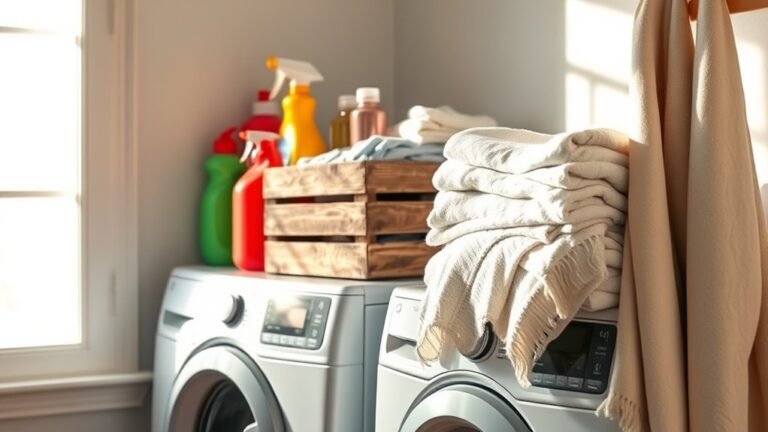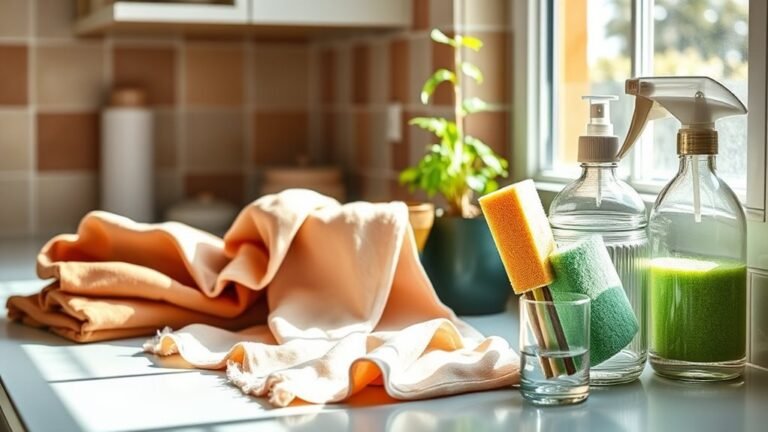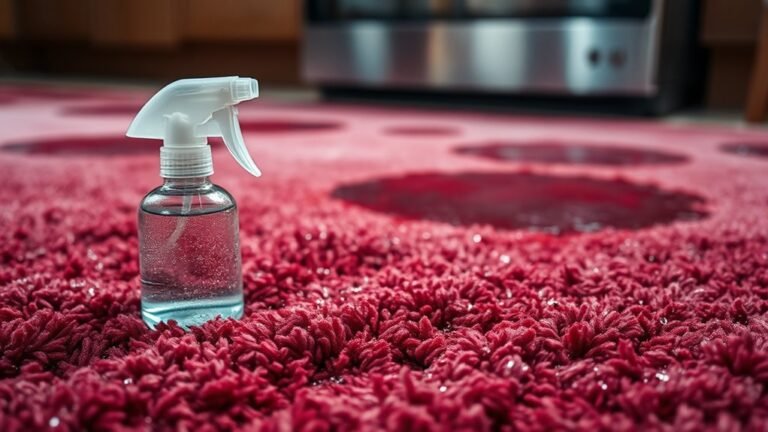How to Clean Smoke Damage After a Kitchen Fire
After a kitchen fire, first assess the smoke damage by checking walls, ceilings, and hidden spots. Make sure the area is safe—wear gloves and masks, and ventilate well. Gather cleaning supplies like microfiber cloths, mild detergent, and a vacuum with a HEPA filter. Gently remove soot using dry sponges or brushes, then clean surfaces with soapy water. To fight odors, increase airflow and use neutralizers. Keep going to uncover how to tackle lingering smells and prevent future damage.
Assessing the Extent of Smoke Damage

Before you begin cleaning, you’ll need to assess the extent of the smoke damage carefully. This smoke assessment is vital because it helps you understand which areas are affected and how deep the damage runs. Start by inspecting walls, ceilings, and any surfaces for discoloration or lingering odors. Don’t forget to check hidden spots like inside cabinets or behind appliances. A thorough damage evaluation will guide your cleaning efforts, ensuring you target the worst-hit areas without wasting time or resources. By knowing exactly what you’re dealing with, you can approach the cleanup with confidence and efficiency, giving you the freedom to restore your space properly and move forward without lingering issues. This step sets the foundation for a successful recovery from smoke damage.
Ensuring Safety Before Cleaning
Before you start cleaning, make sure the structure is safe to enter and won’t collapse. You’ll want to wear protective gear like gloves and masks to avoid harmful exposure. Also, ventilate the area well to clear out lingering smoke and fumes.
Assess Structural Stability
One essential step in dealing with smoke damage is evaluating the structural stability of your property to guarantee your safety. Before you engage in cleaning, you need to make sure your home’s structural integrity hasn’t been compromised by the fire. Walls, ceilings, and floors can weaken, creating hidden hazards that put you at risk. It’s smart to get a professional fire inspection to assess any damage that’s not immediately visible. These experts can spot weaknesses and advise if repairs are necessary before you start cleaning. Taking this step lets you reclaim your space confidently and safely, without risking injury or further damage. Remember, freedom comes with responsibility—protect yourself by ensuring your home stands strong first.
Wear Protective Gear
Since smoke damage can leave behind harmful particles and toxins, you’ll want to protect yourself by wearing the right gear. Donning proper protective clothing and safety equipment guarantees you stay safe and free from irritants while cleaning. This isn’t just about comfort—it’s about safeguarding your health and maintaining your independence during cleanup.
| Protective Clothing | Safety Equipment | Purpose |
|---|---|---|
| Gloves | Respirator Mask | Shield skin & filter air |
| Long-sleeved shirts | Safety Goggles | Prevent irritation & eye injury |
| Durable pants | Hard Hat | Protect legs & head |
| Closed-toe shoes | Disposable Coveralls | Guard feet & avoid contamination |
Equip yourself properly, and you’ll tackle smoke damage confidently and safely.
Ventilate the Area
To start cleaning smoke damage safely, open all windows and doors to ventilate the area thoroughly. This simple step is your first line of defense, allowing fresh air to replace the smoky, harmful particles that linger after a kitchen fire. Embracing airflow strategies like cross-ventilation maximizes natural ventilation, speeding up the removal of odors and toxins. You want to create a steady flow of air, so position fans near openings to pull in clean air and push out contaminated air. Proper ventilation not only makes the cleanup process easier but also protects your health and gives you the freedom to breathe easy. Before you engage in cleaning, verify the space feels fresh and clear—this is vital for your safety and comfort throughout the restoration.
Gathering Necessary Cleaning Supplies
Before you plunge into cleaning smoke damage, you’ll want to gather all the necessary supplies to make the process as efficient as possible. Having the right cleaning tools on hand helps you tackle smoke cleaning without unnecessary delays or frustration. Start with heavy-duty rubber gloves and masks to protect yourself from harmful particles. Grab microfiber cloths, sponges, and scrub brushes for wiping surfaces. You’ll also need a vacuum with a HEPA filter to safely remove soot. For cleaning agents, stock up on mild detergents, specialized smoke cleaning solutions, and white vinegar for natural deodorizing. Don’t forget garbage bags for debris and old rags for stubborn spots. By preparing these essentials, you’re setting yourself up for a smoother, more effective cleanup—and reclaiming your space faster.
Removing Soot and Smoke Residue From Surfaces

Although soot and smoke residue can seem stubborn, you can effectively remove them from most surfaces with the right approach. Start by gently brushing off loose soot without rubbing it deeper into the material. For thorough soot removal and surface cleaning, try these steps:
- Use a dry sponge or a vacuum with a brush attachment to lift soot carefully.
- Apply a mild detergent mixed with warm water on a soft cloth for washable surfaces.
- Avoid harsh scrubbing to prevent damage or spreading the residue.
- Rinse with clean water and dry immediately to stop stains.
Eliminating Lingering Smoke Odors
To get rid of stubborn smoke odors, you’ll want to start by increasing ventilation in your space. Opening windows and using fans can help flush out the smell. You can also use odor neutralizers to tackle any lingering scents more effectively.
Ventilation Techniques
When dealing with smoke damage, one of the most effective ways to eliminate lingering odors is through proper ventilation. Improving air flow helps push smoky air out and brings fresh air in, setting you on the path to a fresher space. Here’s how you can boost ventilation to reclaim your freedom from smoke:
- Open windows and doors to create cross-ventilation.
- Use exhaust fans in the kitchen and bathrooms to pull smoky air outside.
- Set up portable fans to circulate air and speed drying.
- Consider running your HVAC system with fresh air intake to filter and refresh indoor air.
These steps help clear out trapped smoke particles, making your home feel breathable again without relying on heavy chemicals or temporary fixes.
Odor Neutralizing Methods
Ventilation plays a big role in clearing out smoke, but it might not fully erase stubborn odors. To truly reclaim your space, you’ll want to use odor absorbing materials and essential oils. These natural solutions trap and neutralize smoke particles, freeing your home from lingering smells without harsh chemicals.
Here’s a quick guide:
| Method | How It Works |
|---|---|
| Activated Charcoal | Absorbs odors from the air |
| Baking Soda | Neutralizes odors on surfaces |
| Essential Oils | Adds pleasant scents and masks smoke |
Combine these methods for best results. Place odor absorbing materials around the kitchen and add a few drops of essential oils to cotton balls. You’ll breathe easier and enjoy your fresh, smoke-free freedom in no time.
Preventive Measures to Avoid Future Smoke Damage

Although smoke damage can be challenging to clean, you can greatly reduce the risk of future incidents by taking a few key preventive measures. Embracing fire prevention and kitchen safety helps you maintain control and freedom in your home. Here are some essential steps:
- Keep a fire extinguisher nearby and know how to use it.
- Regularly clean cooking surfaces and appliances to prevent grease buildup.
- Never leave cooking unattended, especially when using oil or high heat.
- Install smoke detectors and check their batteries monthly.
Frequently Asked Questions
How Long Does Smoke Damage Restoration Usually Take?
You’ll find the restoration timeline varies depending on the extent of the damage and the thoroughness of the damage assessment. Typically, it can take anywhere from a few days to a couple of weeks. Since you want to get back to normal quickly, a detailed damage assessment helps prioritize what needs immediate attention. Don’t rush the process—it’s about freeing your space from smoke’s effects completely, so patience pays off.
Can Smoke Damage Affect My Home’s Electrical System?
It might feel like your whole world’s been turned upside down if smoke damage sneaks into your home’s electrical system. You’ve got to get a thorough electrical inspection because smoke can cause wiring damage that’s not always visible but seriously dangerous. Don’t let hidden issues limit your freedom or safety—catching problems early means you can keep your home running smoothly without unexpected shocks or outages. Stay proactive and free!
Should I Hire a Professional or Clean Smoke Damage Myself?
Deciding whether to tackle smoke damage yourself or call in professional services depends on your comfort and the damage’s extent. If you enjoy DIY cleaning and the damage is light, you might feel empowered handling it on your own. However, for stubborn stains or extensive damage, professionals have the tools and expertise to restore your space safely and efficiently. Ultimately, choose what gives you freedom without risking your health or home’s integrity.
What Types of Insurance Cover Smoke Damage From Kitchen Fires?
When dealing with smoke damage from kitchen fires, you’ll want to check if your homeowner’s insurance or fire insurance covers it. Usually, homeowner’s insurance includes smoke damage as part of fire coverage, giving you freedom to restore your home without breaking the bank. Make sure to review your policy details, so you know what’s covered and how to file a claim. That way, you’ll be prepared to handle repairs confidently and independently.
Are There Health Risks Associated With Lingering Smoke Particles?
When the air holds onto those invisible whispers from smoke, it’s more than just a faint reminder—it can subtly impact your well-being. You might notice some health effects if you’re exposed to lingering smoke particles for too long. Particle exposure can irritate your lungs, eyes, and throat, making it harder to breathe freely. To protect your freedom to live fully, it’s wise to clear the air and breathe easy again.






